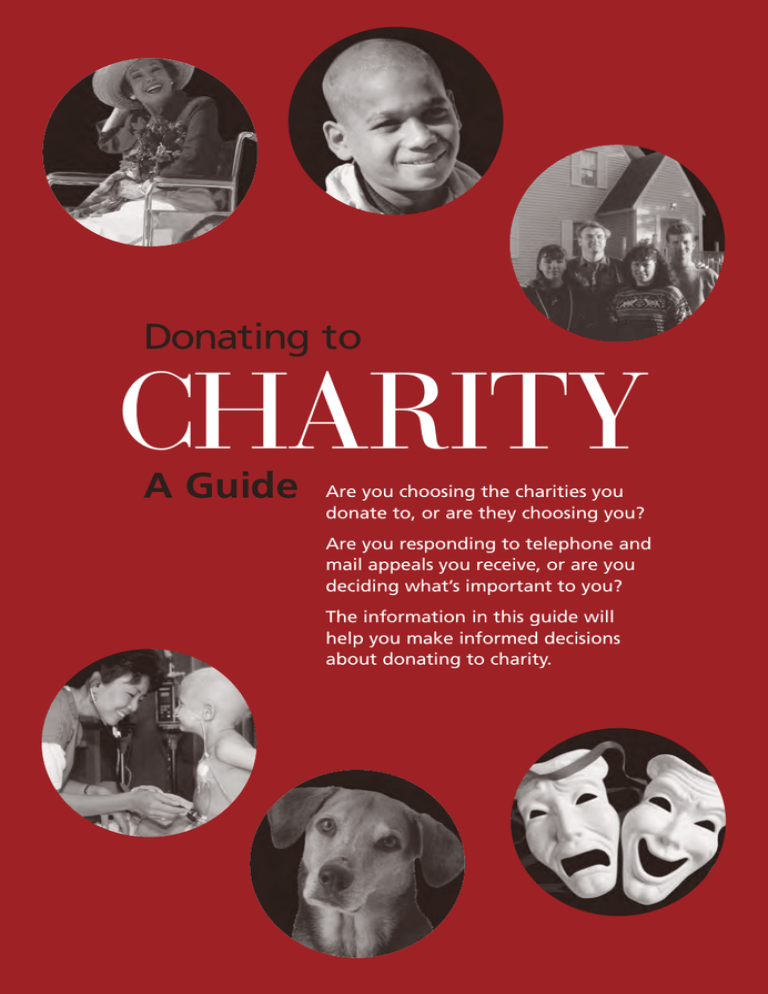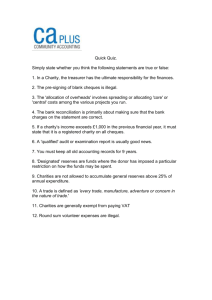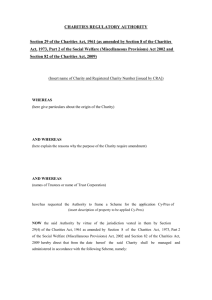
Donating to
CHARITY
A Guide
Are you choosing the charities you
donate to, or are they choosing you?
Are you responding to telephone and
mail appeals you receive, or are you
deciding what’s important to you?
The information in this guide will
help you make informed decisions
about donating to charity.
Nonprofit Overhead Cost Project
This guide is based on information collected by the
Nonprofit Overhead Cost Project. The goal of the project is to understand
how nonprofits raise, spend, measure, and report funds for fundraising
and administration, and to work with practitioners, policymakers, and
the accounting profession to improve standards and practice in these
areas. The project is a collaboration between the Center on Philanthropy
at Indiana University and the Center on Nonprofits and Philanthropy
at the Urban Institute. For more information on the project, see
http://www.coststudy.org.
The Nonprofit Overhead Cost Project was supported by the Atlantic
Philanthropies, the Ford Foundation, the Charles Stewart Mott Foundation,
The David and Lucille Packard Foundation, and the Rockefeller Brothers
Fund. Project researchers who contributed to the content of this guide
are Kennard Wing, Mark A. Hager, Patrick M. Rooney, and Thomas Pollak.
Copyright © 2004. The Urban Institute and Indiana University. All rights reserved.
Conclusions or opinions expressed are those of the authors and do not necessarily reflect the
views of staff members, officers or trustees of the Institute or the University, advisory groups,
or any organizations that provide financial support.
Are you a smart donor? Using this guide,
you can make your charitable donations
go a lot further.
CHARITY
Choosing a
Are you choosing the charities you
donate to, or are they choosing you?
You’ll get greater satisfaction from
your donations, and more bang for
your buck, if you take the time to
choose the charities you support.
But how do you do that?
Charlie started off right. He decided
that he wanted to help the homeless.
Charities are working on an incredible
diversity of issues and problems. You
can’t support them all. You probably
don’t want to. So step one is to make
a list of what you want your money
to work on. Do you want to fight
poverty, racism, sexism, disease,
hunger, or illiteracy? Do you want
to support the arts, revitalize urban
neighborhoods, educate youth, or
prevent violence? Do you want to
encourage people to vote, protect
the environment or animals, promote
healthy lifestyles, or any of a thousand
other things? Pick your top priorities.
Some are easy. Many people already
know specific charities they want to
support, such as their church, a school
they attended, or an organization that
personally helped them or someone
they care about. But how do you find
a charity you don’t already know
about?
Let’s look at the wrong way to do
it first. Charlie decided he wanted
to help the homeless. He went to a
website that allows donors to search
databases of charities and rate them
using financial criteria. He did a
search and found all the organizations
that have something to do with the
homeless. He ranked the list based
on which ones spent the least on
administration and fundraising,
and sent a check off to the one
with the lowest percentage.
Once you know what you want your
gifts to work on, you need to think
about how you want to work on
them. Research centers try to deepen
our understanding of root causes and
develop ways of solving or preventing
a problem, such as discovering HIV
and how it causes AIDS. Direct
service organizations help individuals
facing a particular set of problems with
education, counseling, or other direct
assistance, such as teaching the blind
1
to read Braille. Advocacy organizations
attempt to educate the general public
and influence public policy in a
particular area, such as overturning
zoning that excludes affordable housing
from suburban neighborhoods. Charlie
didn’t take the time to think about
how he wanted to help the homeless.
approaches is superior to the others.
Learn all you can, then pick the one
you believe in or the one that makes
sense to you.
Charlie forgot to ask one more
important question: is this organization making a difference? It’s a tough
one, because most charities don’t have
strong evidence regarding the impact
they’re having. The best you’ll be able
to do is investigate and form a judgment. Most organizations at least have
statistics on the volume of work they
do, and anecdotes about the impact
they’ve made. Use those to form your
judgment. By choosing a more effective organization, your donation will
have more impact on the world.
Even within these broad categories,
different charities operate from very
different philosophical and value
bases. You’ll have to make important
choices. If you are concerned with
pregnancy and sexually transmitted
diseases, for example, you must
choose between agencies that promote
abstinence and those
that promote
Learn all you can, then pick the one you
believe in or the one that makes sense to you.
condom use. To help
the urban poor, you have
to choose between agencies trying to
help people get out of a bad neighborhood, and those trying to improve
the neighborhood. Even in the arts,
there are theatre troupes that reach
audiences effectively by taking
liberties with Shakespeare, and
others that consider that sacrilege.
Despite the strong feelings on
all sides, we usually don’t know
objectively whether one of the
A charity that passes your scrutiny
this far is probably worthy of your
support. If you haven’t already done
so, review its brochures, website,
and annual report. Find out who’s
on the board of directors. Find out
how much money the organization
spends, where the money comes
from, and how that money gets spent.
If it’s important to you, confirm that
your gift is tax deductible (gifts to
some kinds of tax-exempt organizations are not tax deductible). You can
2
get a lot of information about all
charities at www.guidestar.org. In
addition, there are other websites
that provide information on smaller
groups of charities. You can also learn
about charities by talking to people.
Let’s talk
about effectiveness first.
Overhead
pays for the
organizational
infrastructure that
supports a program.
It’s the rent, electricity, heat, telephone, and furnishings. It’s the
management and
board. It’s accounting, human resources,
and information
technology. It’s
the website you
visited, the
annual report
you read, and
the time of the
people who talked to
you when you called. Overhead
isn’t waste; it’s the basis for mission
effectiveness.
At this point, you’re confident it’s
a legitimate charity and will be a good
steward of your gift. Go ahead, send
a check. Keep records, donate regularly, donate as much as you can, and
follow the progress of the charity.
But What About
Overhead Costs?
If you’ve read magazine articles aimed
at helping donors, you’ve likely been
encouraged to focus on overhead costs,
like Charlie did. Plenty of fundraising
appeals feature the organization’s
extremely low overhead costs, and
claim that all (or almost all) of your
donation will be spent on program
activities. It’s reasonable to want your
gift to help someone in need directly
rather than pay the charity’s electric
bill. It’s only common sense that an
organization with lower overhead is
making better use of your gift, right?
The Nonprofit Overhead Cost Project
found wide variation in the adequacy
of organizational infrastructure. Some
charities included in the study had
nice facilities, the latest computers
and software, and highly experienced
and sufficient staffing in supporting
functions, such as accounting, information technology, and fundraising.
At other charities, rain came through
Maybe not. In fact, research shows
that the overemphasis on low overhead, far from enhancing the efficiency of charitable organizations, has
reduced their effectiveness and
corrupted their accounting.
3
the roof, computers were mismatched
hand-me-downs, software was makedo, and key support staff had limited
training or experience for their roles,
or were part-time because this was all
the organization could afford.
is better. And by
and large, you
get what you
pay for.
The other reason
not to place excessive
reliance on overhead ratios is that the
numbers may not be accurate. This
stems from three sources, which we
take up in turn.
These limitations had consequences
for the effectiveness of these organizations. The mismatched computers
frequently crashed and were expensive
to maintain. Weak financial staff and
software meant charities didn’t really
know where the money was going,
and financial controls were often
inadequate as well. Poor software
meant charities didn’t have good
information about what they were
accomplishing that they could share
with donors and other supporters, or
wasted money on fundraising that
wasn’t properly targeted.
The weak accounting at charities that
spend too little on overhead leads to
inaccurate reporting of their overhead
costs. One important category of
overhead costs is fundraising costs.
The Nonprofit Overhead Cost Project
found that 37 percent of charities
reporting over $50,000 in contributions to the IRS reported zero
fundraising costs. Two of these organizations were the focus of detailed case
studies. Both were wrong. One had
over $500,000 in actual fundraising
costs. No one had noticed the zero
until researchers asked about it. The
other charity had a staff person who
did nothing but fundraising, and they
also did some direct mail fundraising.
Until shortly before the study, no one
with financial training was on staff.
None of the organizations in this
study was an extravagant spender on
overhead items, and while there are
undoubtedly some charities that are,
by far the more common problem is
spending too little on the organizational infrastructure that is the foundation for effective programs over the
long term. Lower is not better—better
4
The second reason you must be
cautious about the reported numbers
is that many charities are responding
to the pressure for low overhead, and
the unwillingness of public and private sector funders to pay for it, by
underreporting their overhead. The
Nonprofit Overhead Cost Project
found that only 25 percent of nonprofits that get grants from foundations properly report those proposalwriting costs as fundraising. Only 17
percent of nonprofits getting grants
from government properly report
those proposal-writing
costs as fundraising.
statements. This can have dramatic
effect on the overhead ratio. For
example, a literacy agency that made
extensive use of volunteer tutors
appeared to have a low overhead
ratio of 12 percent when the value
of donated space and services was
included, but a high overhead ratio
of 30 percent when they were left out.
Future Contributions
Charities frequently receive contributions that can only be spent in fiscal
years after the one in which they are
received. Research shows that these
future contributions are not always
Decisions based on simplistic overhead ratios
can lead to flawed conclusions.
Finally, the complexity of reporting rules and some unique
nonprofit accounting issues mean that
decisions based on simplistic overhead
ratios can lead to flawed conclusions,
even when the numbers are accurate.
Here are a few examples.
reported in the same way to the IRS.
One charity could seem to have a
higher fundraising cost than another
because of this difference, even if an
apples-to-apples comparison would
show it to have a lower fundraising
cost in reality.
In-kind Donations
Some charities receive significant noncash contributions, such as rent-free
facilities or donated professional services. The value of donated space and
services is not included in the expenditures of charities when reporting to
the IRS, even though they are valued
at market rate in audited financial
Affiliates
Some charities are single corporations;
larger ones are often conglomerates of
multiple, affiliated nonprofit corporations. In most cases, each corporation
must report to the IRS separately.
Research shows that conglomerates
typically report all or most of their
overhead in one of those corporations,
5
If you are concerned how much of your donation will be used to cover fundraising costs, you
need to focus not on the organization’s average
fundraising cost, but its cost for the method
through which you are going to donate.
What about Charities That
Come to Me for Money?
Often a charity comes to you in a very
personal way. A friend or relative asks
you to donate. Or a particular charity
is suggested for memorial gifts in lieu
of flowers. In these cases, we generally
rely on the judgment of those we
know instead of investigating the
charity ourselves. That’s fine.
often the parent, and report unusually
low overhead in all the other affiliated
organizations. The reported overhead
percentage of one of those subsidiaries
could be lower than another charity’s,
even if the latter actually spent less on
overhead.
Major Gifts
Sometimes a charity receives a gift
so large that the overhead ratio for
that year plummets. On the other
hand, the costs of soliciting such large
gifts have been incurred for years
in advance, increasing the overhead
ratio in those years. Comparing two
charities using just one year’s data
can create a false picture.
Even more often, we get a phone call
or mailing asking for a donation for
a charity we don’t know anything
about. Here’s what you should know
before you write that check:
You’ll never hear
from most charities
You may think you get a lot of calls
or mail from charities, but only a
small minority uses these methods
extensively. Research shows that only
9 percent of charities use telephone
solicitation. Although 43 percent
use direct mail, most of these do
not mail to strangers. The charities
that best fit your values aren’t likely
to come to you.
In short, the numbers and rankings
that Charlie found at that website
added nothing to his understanding
of the relative overhead spending
of the charities he was considering,
and likely led him to support
an organization that, on closer
inspection, would not have been
his first choice.
6
Make sure the
charity is legitimate
While many fine charities use mail
and phone to raise contributions,
these are also the methods most likely
to be used fraudulently. One common
scam is to create a name that sounds
very similar to a reputable, well
known charity. Another is to suggest
a link to a hard-to-say-no-to group,
such as police, firefighters, or veterans.
If the cause sounds like one you’d like
to support, make a brief investigation
before deciding to donate. The
website www.guidestar.org contains
information on all charities.
frequently run the campaign at
breakeven or even at a loss. That
means 100 percent of your first donation will likely be spent on fundraising. If you stick with the charity, however, your future gifts will go toward
the work you want to support.
Bigger gifts mean less
goes to fundraising cost
The cost of calling you or mailing
to you remains the same regardless
of the amount you give. That means
you can reduce the portion of your
gift spent on fundraising by increasing your gift. Suppose, for example,
that it costs $0.25 to mail an appeal
to past donors and that 25 percent
of people who receive the mailing
make donations. That would make it
cost $1 to raise each donation. If you
give $5, then 20 percent of your
donation pays for soliciting the gift.
If you give $50, then almost all your
money goes to support the charity’s
programs.
Understand the costs
of donor acquisition
If you are only planning to make one
donation to a new organization that
reaches out to you by mail or phone,
you probably shouldn’t bother.
Because they expect you to make
multiple donations in the future,
fundraising professionals
are willing to spend a
significant amount
of money to get
that first donation.
A charity calling or
mailing to known
past donors expects to
raise much more money
than the cost of the
solicitation. A
charity trying to
build its list of
donors will
Understand the costs of
different fundraising methods
Reported fundraising cost ratios are
an average across various fundraising
methods with significantly different
costs. If you are concerned how much
of your donation will be used to cover
fundraising costs, you need to focus
not on the organization’s average
fundraising cost, but its cost for the
method through which you are going
to donate. For example, one expensive
7
Supporting Education or
Supporting Fundraising?
Charities that make extensive use of
mail and phone to raise money (tens
of thousands of contacts per month)
frequently combine educational material with the appeal for donations and
consider that education part of their
program activity. A good part of your
donation may go to more of the same
kind of mail or phone activity that
reached you. You might think it
way to donate money is those fancy
charity dinners you see in the society
pages. Frequently a majority of the
check you write goes for the cost of
the event. Another expensive way to
donate is to make a purchase you
don’t really want or need, a portion
of which goes to charity: typically
only 10 to 20 percent of the money
you spend goes to the charity. Before
you respond to one of
these solicitations,
The charities that best fit your values aren’t
likely to come to you.
important that the charity is getting
the word out and want to support
that, or you might think it mostly
fundraising and not want to support
it. Both accounting and IRS rules
allow charities to classify some of
the costs of such combined activities
as program costs. Such a decision can
cut a charity’s reported fundraising
costs in half. You can find out
whether the charity uses this option
by viewing the Form 990 it files with
the IRS at www.guidestar.org (look
for “joint costs” just below the
Statement of Functional Expenses
ask how much
actually goes to the charity. Your
money will go a lot further if you
simply write a check to the charity.
Have you thought about donating
a car to charity? Typically, such cars
are sold at wholesale auction and
a “processing fee” subtracted by the
for-profit company that collects and
sells the cars. Charities get much less
than the retail value of the car and,
in the case of a junker, may even be
charged for your gift. An alternative
is to sell the car yourself and send
a check to your favorite charity.
8
on page 2 of Form 990). If
you see a big number there,
that’s where a good part of
your donation will go, too.
Make sure those phone calls
and mailings are the kind of
expenses you want to support before
you write a check.
These cautions don’t mean you should
never donate to charities that come to
you. They just mean that you need to
do the same kind of investigation as
for charities you seek out. Annual
or more frequent gifts to reputable
charities that call or mail you can be
an important part of your overall
charitable giving, providing these
charities are working on issues you
want to support.
There are so many
pitfalls, maybe
I shouldn’t give at all.
The information in this guide has
been prepared to make you a smarter
donor, not to discourage you from
giving to worthy charities. The vast
majority of charities in this country
are working very hard with too little
money on the most important and
most
difficult
issues
facing our
society. You
never hear from most of them.
It would be wonderful if all donors
could give more money to most charities. That may not be possible, but we
can all give more intelligently, so that
more of the money we give gets to the
charities instead being eaten up by
middlemen or fundraising expenses,
more of the money we give goes to
the most effective charities, and more
of the money we give goes to the
charities working on the things we
care most about.
When you give generously to charities
you know are effective at the things
you care most about, you get back in
satisfaction much more than the value
of your donations.
URBAN INSTITUTE
Center on Nonprofits and Philanthropy
INDIANA UNIVERSITY
Center on Philanthropy
www.coststudy.org




